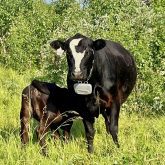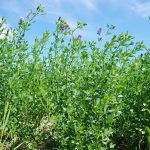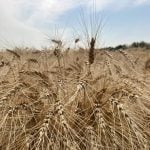Ancient Greece and Rome were well acquainted with anthrax many famous scholars from those times mentioned it in their writings.
Today we continue to write about anthrax, partially because the soil-borne pathogen continues to surface as a livestock killer, mostly in small outbreaks, but makes remarkable news when discussed in the context of biological warfare and bombs full of spores. Each time anthrax hits the news, the veterinary community goes through a list of questions, resembling the catalogue of inquiry scientists used when describing anthrax as a clinical entity in the 1700s. Where did it come from? What recent changes allowed spores to multiply and kill? Has predation allowed spores to spread? Where to from here?
Anthrax occupies an important place in the annals of scientific literature:
- 1700s – First clinical descriptions of anthrax.
- 1877 – Robert Koch uses anthrax to develop his famous Koch Postulates.
- 1881 – Louis Pasteur creates the first vaccine for anthrax.
- 1900s – Anthrax is well documented in the U.S., but remains undocumented in other countries.
- 1937 – Anthrax vaccine for animals reduces anthrax cases in humans.
A spore-forming bacteria called Bacillus anthracis causes anthrax, a potentially fatal disease in man, domestic livestock and many wildlife species. When an animal dies of anthrax, highly resistant spores are formed by bacteria when discharged from the animal or exposed to oxygen if the carcass is opened. Spores survive in soil through extremes in temperature and moisture for decades. Some scientists suggest herds of prairie bison played a role in seeding large areas of range with highly resistant spores.
Read Also

The Canadian Cattle Association’s international advocacy efforts
Global ag policies affect Canadian food policy, so the Canadian Cattle Association participates in international and domestic forums
[RELATED] Alberta Farmer Express: For the first time in generations, bison have returned to traditional lands
Spores are very buoyant and shift with natural water flows. They are brought to the surface when environmental conditions are right. For example, floods move spores, drying of wet areas exposes spores to grazing livestock, disruption of the soil by excavation will redistribute spores. When animals graze range where spores are present, spores are ingested and transformed into rapidly multiplying bacteria that produce deadly toxins. Cases of naturally occurring anthrax are reported every year in Canada.
Anthrax is a zoonotic disease and can be transmitted to humans. Human infections from animals are uncommon and primarily restricted to contact with contaminated wool and hides. Intentional dissemination of spores has been used by warring nations as a form of biological warfare for centuries. The accidental release of spores from a Russian laboratory at Sverdlovsk researching biological warfare killed 60 to 100 residents. During World War II, the British army bombarded the small Scottish island of Gruinard with anthrax spores as part of a biological weapons experiment, to test the effectiveness of such attacks in warfare. It quickly became apparent anthrax used in this manner renders areas uninhabitable for long periods. The island remained contaminated and dangerous for any mammal for decades, until cleaned during a very expensive and difficult decontamination effort. Soon after the terrorist attacks of 9/11, letters laced with anthrax began appearing in the U.S. mail. Five Americans were killed and 17 were sickened in what became the worst biological attack in U.S. history.
[RELATED] Texas A&M researchers developing first oral anthrax vaccine for livestock, wildlife
Within Canada, anthrax is a provincially and federally notifiable disease. Anthrax is widely distributed across all areas of the world, including the Arctic. The Yamal Peninsula in the Russian Federation experienced a massive outbreak of anthrax in domestic reindeer herds between July and August 2016, with 2,650 (6.46 per cent of the total susceptible population) animals infected, of which 2,350 died (case fatality rate of 88.67 per cent). Abnormally high ambient temperature in the summer of 2016 helped thaw permafrost, exposing viable Bacillus anthracis spores. The monthly average air temperatures in June, July and August 2016 were 20 to 100 per cent higher than those of the previous 30-year period.
Anthrax is a sporadic disease that may not occur for many years, then suddenly reappear or appear in areas where there is no recorded occurrence. A few sporadic cases of anthrax are reported in Western Canada nearly every year, with repeated outbreaks in the Mackenzie bison range in the Northwest Territories and Wood Buffalo National Park in northern Alberta. Recently anthrax killed pastured cattle on range near Piapot in southwestern Saskatchewan, near the Saskatchewan-Alberta border.
In Canada, cases are typically reported between July to September and usually following periods of hot and dry, or hot and wet weather. But it has been reported in every season, including winter.
Typically, several years span periods between outbreaks. Control protocols are designed to minimize soil contamination and reduce the chance the disease will persist or reoccur. Once anthrax appears in any area, future risk is higher because of increased environmental contamination with spores.
Vaccination will protect susceptible animals within seven to 10 days. Talk with your veterinarian about vaccination. They will help you decide whether vaccination in your herd is appropriate based on disease risk in your area. Preventive antimicrobial treatment of exposed animals can be effective.
Central to the persistence of anthrax in an area is the ability of B. anthracis to form long-lasting, highly resistant spores. Understanding the ecology of anthrax spores is essential if one hopes to control epidemics. Studies on the ecology of anthrax have found a correlation between the disease and specific soil factors, such as alkaline pH, high moisture and high organic content. Researchers initially suggested that these factors influenced vegetative anthrax bacilli. However, subsequent research has shown that vegetative cells of B. anthracis have very specific nutrient and physiological requirements and are unlikely to survive outside a host. A review of the properties of spores of B. anthracis and soil factors linked to epidemic areas reflect important environmental conditions that aid the anthrax spores in causing epidemics (Dragon DC, Rennie RP. Canadian Veterinary Journal, 1995 May;36(5):295-301). Specifically, high calcium levels in the soil may help to maintain spore vitality for prolonged periods and cycles of runoff and evaporation may collect spores dispersed from previous epidemics into storage areas, thereby concentrating them.

















